NSKK Crash Helmet (1st pattern)
CATEGORY: Version
SKU: 53.GOR.01.02.003.000
Estimated market value:
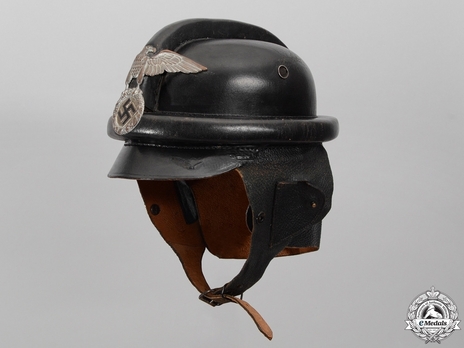
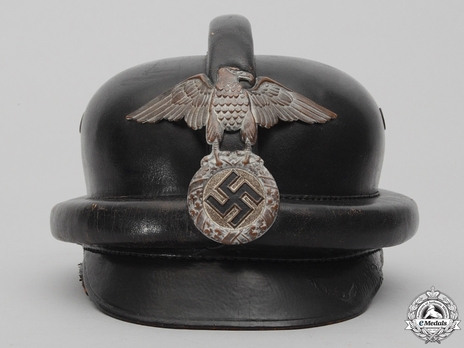
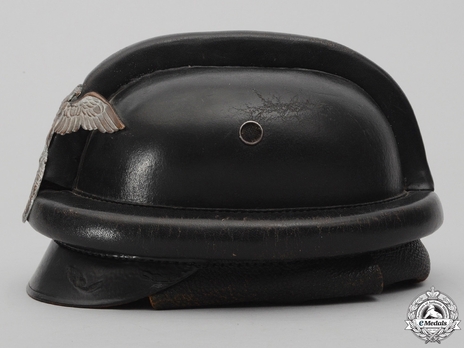
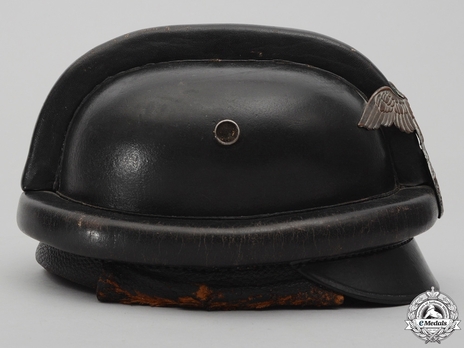
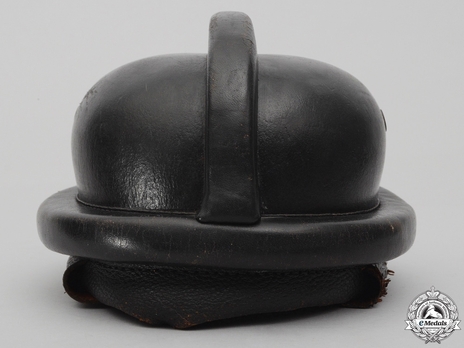
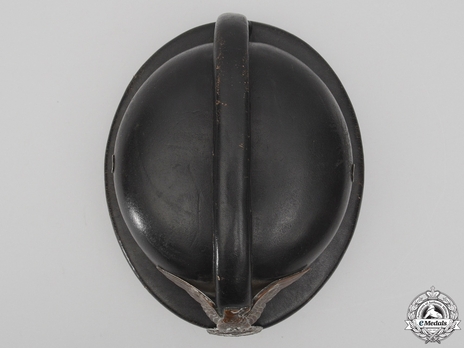
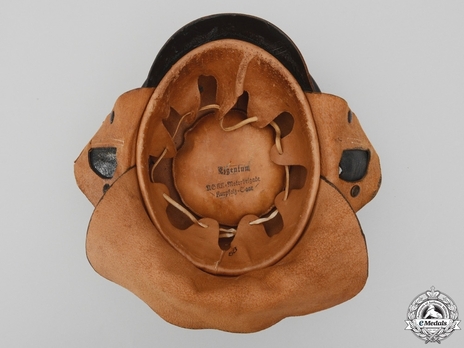
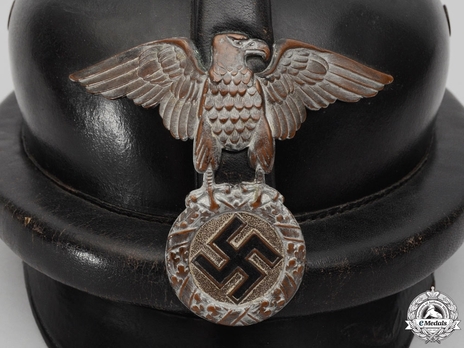
Estimated market value:
1st Pattern NSKK Crash Helmet, constructed of molded, smooth, blackened leather helmet with raised, padded, protective bars running horizontally around the helmets bottom edge, and another protective bar running from front to back over the crown top. Helmet has a single ventilation grommet with screen to each side of crown. Front center of helmet has a 1st pattern NSKK stylized national eagle, still very firmly held in its correct position, nicely imbedded. Helmet has a short blackened leather visor stitched to front and stitched on, extended, blackened, grained, leather, protective side and rear panels. Side panels each have a vertical half-moon shaped, ear cut-out with stitched on closure flaps. Flaps were designed to protect the ears while still allowing for hearing. Rear neck flap intact. Side panels also have extended straps to bottoms which act as the chinstrap. Interior of helmet has a tan leather; the bottom is unit marked “Eigentum NSKK-Motorbrigade Kurpfalz-Saar”. Liner is fully intact with all fingers and original tie string. Liner is size ink stamped, "58". Moderately worn, and a very nice example!
The NSKK (Nationalsozialistisches Kraftfahr-Korps = National Socialist Motor Corps) was a paramilitary organisation affiliated with the NSDAP, specialising in anything related to the driving of motorised vehicles. NSDAP officials recognised the need for access to cars and trucks for both transportation and propaganda purposes as early as 1922, and certain steps were taken to ensure this need was met. However, it took until April of 1930 for a specialised motor organisation to be officially founded. This organisation was named NSAK (Nationalsozialistisches Automobil-Korps = National Socialist Automobile Corps), but was renamed to NSKK less than 13 months later.
Initially, the NSAK/NSKK was under the control of the SA and existed next to its parent organisation’s own driving-related sub-organisation, the Motor-SA. This changed after the “Night of the Long Knives”, in which many SA leaders were purged and the organisation was substantially disempowered. After July of 1934, the NSKK became an independent organisation whose leader, NSKK-Korpsführer Adolf Hühnlein, answered directly to Adolf Hitler.
The main tasks of the NSKK were to provide transportation for all organisations of the Third Reich, to train and instruct boys and men (and a number of women) in mechanics and driving, and to assist police in regulating traffic. During the mid 1930s, the organisation also provided roadside assistance.
With the onset of the war, the NSKK’s tasks underwent certain changes. Instructing both civilians and soldiers in the driving and maintenance of armored vehicles became a higher priority. The NSKK also began working closely with other organisations, for example Organisation Todt (OT), by providing transportation of workers and supplies for the colossal building project that was the fortification of Germany’s Western border, the Siegfried Line (or Westwall). During the war, the NSKK provided much of the transportation needs for the German Army and the Luftwaffe, including the transport of troops, weapons and ammunition, and building materials, for example for the construction of air bases in the newly conquered territories in Eastern Europe after the attack on Soviet Russia in the summer of 1941.
Parts of the NSKK would come under the control of architect Albert Speer who took over OT after the death of Fritz Todt in 1942, leading to the creation of Transport Brigade Speer (later Transport Corps Speer), which would eventually completely sever its ties to the NSKK.
Members of the NSKK wore the same pattern of Crash Helmet as members of the Motor-SA, but with a different helmet badge. The visored helmets were produced out of leather that was 2.5-3 mm thick or vulcanised fibre that was around 1.5mm thick. Although the vulcanised fibre is thinner, it is a much stronger material. A protective tube-shaped layer of padding is attached to the lower edge helmet, as well as to the top of the helmet, spanning from the forehead area to the back. A protective leather flap covers the back of the head and features closeable ear flaps. A leather strap fastens under the wearer’s chin with a metal buckle.
The helmet was originally issued with an SA pattern helmet badge, which depicts a leftward facing eagle with outstretched wings. The eagle is clasping an enwreathed swastika in its talons. The badge is silver in colour, except for the swastika which is painted black.
The crash helmets were eventually issued with an NSKK pattern helmet badge, which features a leftward facing eagle with long, rectangular wings. The eagle claps a wreath with a cutout swastika in the centre. Above the eagle, there is a banner with the initials “N.S.K.K.”.
The crash helmet was worn while driving, and also at special events such as parades.
Some NSKK units that served in mountainous regions attached an Edelweiss insignia to the left side of their crash helmet.
There is a visorless NSKK helmet that was produced with vulcanised leather and without additional padding. The helmet simply features a leather chin strap, as well as a protective neck and ear covering. The front of this helmet features a decal of the NSKK insignia.

Comments
Sign in to comment and reply.


Scroll Top